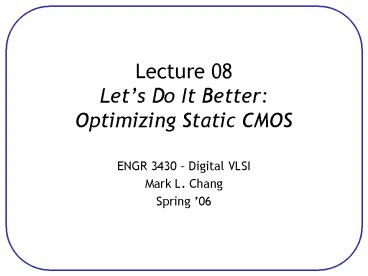Lecture 08 Lets Do It Better: Optimizing Static CMOS - PowerPoint PPT Presentation
1 / 20
Title:
Lecture 08 Lets Do It Better: Optimizing Static CMOS
Description:
... effort by comparing to unskewed inverter with same effective resistance ... the input capacitance of an unskewed inverter delivering the same output current ... – PowerPoint PPT presentation
Number of Views:51
Avg rating:3.0/5.0
Title: Lecture 08 Lets Do It Better: Optimizing Static CMOS
1
Lecture 08Lets Do It BetterOptimizing Static
CMOS
- ENGR 3430 Digital VLSI
- Mark L. Chang
- Spring 06
2
Example
- Sketch a design using AND, OR, and NOT gates
module mux(input s, d0, d1, output
y) assign y s ? d1 d0 endmodule
3
Example
- Sketch a design using NAND, NOR, and NOT gates.
Assume S is available
module mux(input s, d0, d1, output
y) assign y s ? d1 d0 endmodule
4
Bubble Pushing
- Start with network of AND / OR gates
- Convert to NAND / NOR inverters
- Push bubbles around to simplify logic
- Remember DeMorgans Law
5
Example
- Sketch a design using one compound gate and one
NOT gate. Assume S is available
module mux(input s, d0, d1, output
y) assign y s ? d1 d0 endmodule
6
Compound Gates
- Logical effort of compound gates
7
Do it Some More
- The multiplexer has a maximum input capacitance
of 16 units on each input. It must drive a load
of 160 units. Estimate the delay of the NAND and
compound gate designs
8
NAND Solution
9
Compound Gate Solution
10
Finish Up
- Size the transistors to achieve this delay
11
Input Order
- Our parasitic delay model was too simple
- Calculate parasitic delay for Y falling
- If A arrives latest?
- If B arrives latest?
12
Work Sheet
13
Inner vs. Outer Inputs
- Outer input is closest to rail (B)
- Inner input is closest to output (A)
- If input arrival time is known
- Connect latest input to inner terminal
14
Asymmetric Gates
- Asymmetric gates favor one input over another
- Ex suppose input A of a NAND gate is most
critical - Use smaller transistor on A (less capacitance)
- Boost size of noncritical input
- So total resistance is same
- gA
- gB
- gtotal gA gB
- Asymmetric gate approaches g 1 on critical
input - But total logical effort goes up
15
Skewed Gates
- Skewed gates favor one edge over another
- Ex suppose rising output of inverter is most
critical - Downsize noncritical nMOS transistor
- Calculate logical effort by comparing to unskewed
inverter with same effective resistance on that
edge. - gu
- gd
16
HI- and LO- Skew
- Def Logical effort of a skewed gate for a
particular transition is the ratio of the input
capacitance of that gate to the input capacitance
of an unskewed inverter delivering the same
output current for the same transition. - Skewed gates reduce size of noncritical
transistors - HI-skew gates favor rising output (small nMOS)
- LO-skew gates favor falling output (small pMOS)
- Logical effort is smaller for favored direction
- But larger for the other direction
17
Catalog of Skewed Gates
18
Asymmetric Skew
- Combine asymmetric and skewed gates
- Downsize noncritical transistor on unimportant
input - Reduces parasitic delay for critical input
19
pMOS/nMOS Ratio
- We have selected P/N ratio for unit rise and fall
resistance (m 2-3 for an inverter). - Alternative choose ratio for least average delay
- In general, best P/N ratio is sqrt of equal delay
ratio. - Only improves average delay slightly for
inverters - But significantly decreases area and power
20
Observations
- For speed
- NAND vs. NOR
- Many simple stages vs. fewer high fan-in stages
- Latest-arriving input
- For area and power
- Many simple stages vs. fewer high fan-in stages































